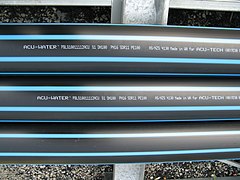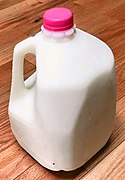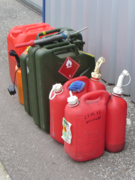Are Tracks Made With High Density Polyethylene
Class of polyethylenes

High-density polyethylene (HDPE) or polyethylene high-density (PEHD) is a thermoplastic polymer produced from the monomer ethylene. It is sometimes called "alkathene" or "polythene" when used for HDPE pipes.[1] With a high strength-to-density ratio, HDPE is used in the production of plastic bottles, corrosion-resistant piping, geomembranes and plastic lumber. HDPE is commonly recycled, and has the number "2" as its resin identification code.
In 2007, the global HDPE market reached a volume of more than 30 million tons.[2]
Properties [edit]
| Density | 940 kg/m3 |
| Melting point | 130.8 °C. |
| Temperature of crystallization | 111.9 °C. |
| Latent heat of fusion | 178.6 kJ/kg. |
| Thermal conductivity | 0.44 W/m.°C. at °C. |
| Specific heat capacity | 1330 to 2400 J/kg-K |
| Specific heat (solid) | 1.9 kJ/kg. °C. |
| Crystallinity | 60% |
HDPE is known for its high strength-to-density ratio.[4] The density of HDPE ranges from 930 to 970 kg/m3.[5] The standard method to test plastic density is ISO 1183 part 2 (gradient columns), alternatively ISO 1183 part 1 (MVS2PRO density analyzer).[6] Although the density of HDPE is only marginally higher than that of low-density polyethylene, HDPE has little branching, giving it stronger intermolecular forces and tensile strength (38 MPa versus 21 MPa) than LDPE.[7] The difference in strength exceeds the difference in density, giving HDPE a higher specific strength.[8] It is also harder and more opaque and can withstand somewhat higher temperatures (120 °C/248 °F for short periods). High-density polyethylene, unlike polypropylene, cannot withstand normally required autoclaving conditions. The lack of branching is ensured by an appropriate choice of catalyst (e.g., Ziegler–Natta catalysts) and reaction conditions.
HDPE is resistant to many different solvents, so it cannot be glued. Pipe joints must be made by welding.
The physical properties of HDPE can vary depending on the molding process that is used to manufacture a specific sample; to some degree, a determining factor is the international standardized testing methods employed to identify these properties for a specific process. For example, in rotational molding, to identify the environmental stress crack resistance of a sample, the notched constant tensile load test (NCTL) is put to use.[9]
Owing to these desirable properties, pipes constructed out of HDPE are ideally applicable for drinking water[10] and waste water (storm and sewage).[11]
Applications [edit]
-

HDPE fibers can be spun into rope
-

Disposable suits; nonwoven HDPE fabric
-

-

Plastic mailing envelopes
-

Flexible HDPE pipes
-

Corrugated HDPE pipe installation in storm drain project in Mexico
-

-

Stools for outdoor use
-

Bottle crates
-

Toys and playground equipment
-

Clear plastic bags (shown) are made of LDPE; blown-film shopping bags with handles are now made of HDPE
-

HDPE is used to make sturdy bottles that resist oils. Transparent bottles are usually made of other plastics, such as polyethylene terephthalate
-

Milk jug
-

HDPE jerrycans resist softening and swelling from aromatic components of fuels
-

Roller on HDPE construction entrance mat
HDPE has a wide variety of applications; for applications that fall within the properties of other polymers, the choice to use HDPE is usually economic:
- 3D printer filament
- Arena board (puck board)[12]
- Backpacking frames
- Ballistic plates
- Banners
- Bottle caps
- Boats
- Chemical containers
- Chemical-resistant piping
- Coax cable inner insulator
- Conduit protector for electrical or communications cables
- Corrosion protection for steel pipelines
- Electrical and plumbing boxes
- Far-IR lenses
- Fireworks
- Folding chairs and tables
- Food storage containers
- Fuel tanks for vehicles
- Geomembrane for hydraulic applications (such as canals and bank reinforcements)
- Geothermal heat transfer piping systems
- Heat-resistant firework mortars
- Housewrap (Tyvek)
- Hovercraft: The material is too heavy and dense for such craft but is still used occasionally
- Ionizing radiation shield[13] [14]
- Laundry detergent jugs
- Lasts for shoes
- Microwave telescope windows
- Milk jugs
- Natural gas distribution pipe systems[15]
- Piping for fluid, slurry and gas purposes
- Plastic bags
- Plastic bottles suitable both for recycling or re-use
- Plastic surgery (skeletal and facial reconstruction)[16]
- Potable water mains[10]
- Root barrier
- Shampoo bottles
- Sewage mains[11]
- Snowboard rails and boxes
- Stone paper
- Storage sheds
- Swimming pool installation
- Trackout control mats
- Telecom ducts[17]
- Water pipes for domestic water supply and agricultural processes[10]
- Wood plastic composites (utilizing recycled polymers)

HDPE sheet which has been extrusion welded
HDPE is also used for cell liners in subtitle D sanitary landfills, wherein large sheets of HDPE are either extrusion welded or wedge welded to form a homogeneous chemical-resistant barrier, with the intention of preventing the pollution of soil and groundwater by the liquid constituents of solid waste.
HDPE is preferred by the pyrotechnics trade for mortars over steel or PVC tubes, being more durable and safer: HDPE tends to rip or tear in a malfunction instead of shattering and becoming shrapnel like the other materials.
Milk bottles, jugs, and other hollow goods manufactured through blow molding are the most important application area for HDPE, accounting for one-third of worldwide production, or more than 8 million tonnes.
Above all, China, where beverage bottles made from HDPE were first imported in 2005, is a growing market for rigid HDPE packaging, as a result of its improving standard of living. In India and other highly populated, emerging nations, infrastructure expansion includes the deployment of pipes and cable insulation made from HDPE.[2] The material has benefited from discussions about possible health and environmental problems caused by PVC and polycarbonate associated bisphenol A (BPA), as well as its advantages over glass, metal, and cardboard.
See also [edit]
- Cross-linked polyethylene (PEX)
- HDPE pipe (HDPE)
- Low-density polyethylene (LDPE)
- Linear low-density polyethylene (LLDPE)
- Medium-density polyethylene (MDPE)
- Phillips Disaster
- Plastic recycling
- Polyethylene (PE)
- Resin identification code
- Stretch wrap
- Ultra-high-molecular-weight polyethylene (UHMWPE)
References [edit]
- ^ Pipe materials. level.org.nz
- ^ a b "Market Study: Polyethylene HDPE". Ceresana Research.
- ^ Thakare, Kavendra A.; Vishwakarma, Honeykumar G.; Bhave, A. G. (December 2015). "Experimental Investigation Of Possible Use Of Hdpe As Thermal Storage Material In Thermal Storage Type Solar Cookers" (pdf). International Journal of Research in Engineering and Technology. Bangalore, India: IJRET/Sun Publications. 04 (12). ISSN 2319-1163. Archived (PDF) from the original on October 30, 2019. Retrieved October 31, 2019.
- ^ Thermoforming HDPE Archived 2012-02-05 at the Wayback Machine. Dermnet.org.nz
- ^ Typical Properties of Polyethylene (PE). Ides.com. Retrieved on 2011-12-30.
- ^ "PLASTIC DENSITY IN 2 MINUTES". www.plastic-density.com . Retrieved 2021-06-18 .
- ^ Askeland, Donald R. (2016). The science and engineering of materials. Wendelin J. Wright (7 ed.). Boston, MA. p. 594. ISBN978-1-305-07676-1. OCLC 903959750.
- ^ Compare Materials: HDPE and LDPE. Makeitfrom.com. Retrieved on 2011-12-30.
- ^ www.rotomolding.org. Retrieved 2016-4-20.
- ^ a b c "Acu-Water | HDPE Blueline Water Pipe". Acu-Tech Piping Systems.
- ^ a b "Acu-Sewer Pressure Pipe for Sewer Mains". Acu-Tech Piping Systems.
- ^ "Puck Board (HDPE Sheets)". Professional Plastics. Retrieved 24 December 2018.
- ^ AstroRad. European Space Agency. 25 January 2019.
- ^ Gaza, Razvan. "International Science Aboard Orion EM-1: The Matroshka AstroRad Radiation Experiment (MARE) Payload" (PDF). nasa.gov . Retrieved 27 August 2019.
- ^ "Acu-Gas Yellow High Pressure HDPE Pipe". Acu-Tech Piping Systems.
- ^ Dermnet.org.nz. Dermnet.org.nz (2011-07-01). Retrieved on 2011-12-30.
- ^ "Acu-Comms White Communications Conduit". Acu-Tech Piping Systems.
Are Tracks Made With High Density Polyethylene
Source: https://en.wikipedia.org/wiki/High-density_polyethylene